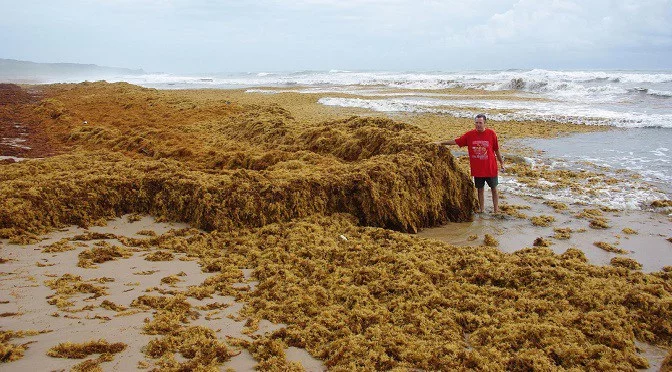Sargassum seaweed: A curse or a blessing Made in Seychelles
10 September, 2018

Bernard Port Louis and his son Benjamin have confirmed that they are ready now to put their product on the Seychelles market and are also vying the Indian Ocean Islands of Reunion, Mauritius, Sri Lanka as well as Europe with liquid fertiliser for foliage and pulverised cooked and dried seaweed for soil conditioning from their Seaweed Factory at Baie Ste Anne at Praslin. The seaweed treatment process plant at Praslin is an example for many tourism destinations and today Seychelles can export its know-how and its natural products coming from seaweed but that is good for landscaping and agricultural farmers.
Bernard and Benjamin Port Louis are now ready to firstly provide much-needed fertilizer for Seychelles, but are also ready for the export market as a commodity with a “Made in Seychelles”. This is part of what Seychelles is pushing as the Blue Economy because seaweed washing up on the beaches of Seychelles during a time of the year comes from the sea and it was until now considered as a challenge for the island’s tourism industry. Today the same seaweed is being used as a crop that provides employment and will be on the list of export products from Seychelles.
Recently an article was published about beaches in the USA suffering with tons of seaweed being bumped by waves and tide onto its beaches. Today we see that the Caribbean is also suffering Loads of seaweed are threatening the Caribbean’s sea life and tourism. Experts say we may be to blame. Workers come from across Mexico to find jobs here, like Pancho Vergada, a 72-year-old guitarist from Veracruz state who plays songs for tourists in Playa del Carmen. The seaweed, he said, is causing him to go broke. In years past, his three-piece band would typically play 20 or 30 songs a day for vacationers drinking beer and eating fried fish at plastic tables set in the sand. These days, the band is lucky if it plays four. (from Kate Linthicum, 08 Sep 11:18 AM Travel News Wire)
The Port Louis Father and Son Team have developed the necessary expertise and could today assist many of the countries make a positive out of the negative impact on tourism from the tons of seaweed sitting on their beaches. The income derived from processing the seaweed could provide employment for hundreds through the collection of the seaweed for processing as natural fertilizer is produced.
In Seychelles the tons of seaweed that is washed on beaches are collected by hand, washed and dried in the sun before being cooked and the liquid fertilizer extracted from it. The factory can today extract 4000 litters of the liquid fertilizer per day based on a 200 litter amount per ton. This liquid fertilizer is used for foliage. After the extraction of the liquid is completed the seaweed is sundried again before being pulverised and turned into fertilizer for use as soil conditioning. The Port Louis Praslin factory is producing today up to 4000 litters of hot water through solar energy which is used for their steam boiler unit for cooking of the seaweed.
It is estimated that in a seaweed season on the island of Praslin about 100 thousand tons of seaweed fall on the island’s beaches and this had resulted for many years with a cry for help by members of the Praslin Tourism Industry. Today Bernard Port Louis and his son Benjamin are showing clearly the capacity and knowhow by Seychellois and are again appealing for the Government of Seychelles to embrace the project that still needs land for drying the tons of seaweed collected.
The father and son team started from scratch and benefited with research work done through the biggest research organisation, the CSIRO of Australia. Benjamin Port Louis is himself a graduate who has returned from Australia with a Degree in Business Innovation and a Masters in Conflict & Dispute Resolution. They acknowledge that they picked up and took notes in the early stages of their planning of the 1981 research work conducted by Viral Dhanjee and Professor Kito Mshigeny of the University of Dar Es’ Salam on Biomass of Brown Algae around the main islands of Seychelles.
The Seychelles Seaweed fertilizer has for the last couple of months been tried by different farmers and the results have confirmed it is good for orchids and also for spraying as a natural fertilizer for vegetable gardening and in sugarcane plantations.
